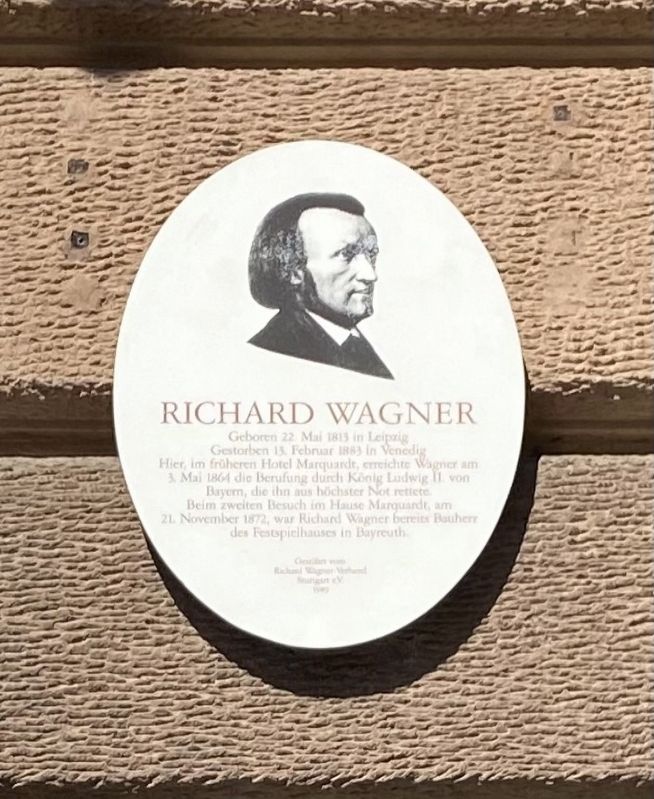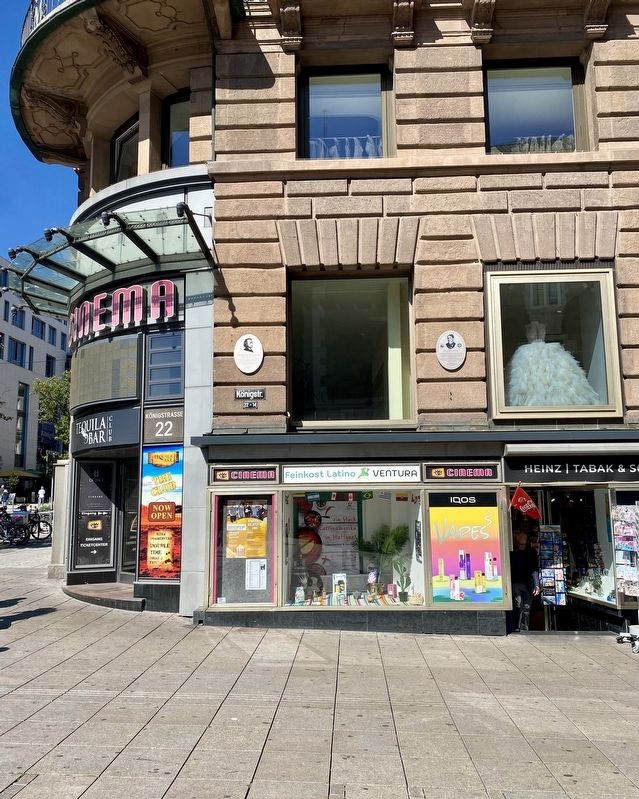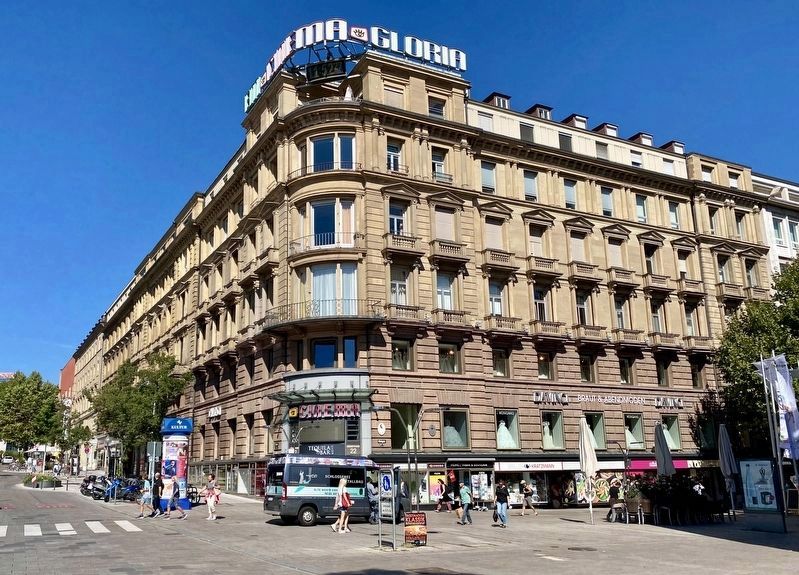Stuttgart, Baden-Württemberg, Germany — Central Europe
Richard Wagner
Gestorben 13. Februar 1883 in Venedig
Hier, im früheren Hotel Marquardt, erreichte Wagner am 3. Mai 1864 die Berufung durch König Ludwig II von Bayern, die ihn aus höchste Not rettete. Beim zweiten Besuch am Haus Marquardt, am 21. November 1872, war Richard Wagner bereits Bauherr des Festspielhauses in Bayreuth.
Born on May 22, 1813 in Leipzig.
Died on February 13, 1883 in Venice.
Here, in the former Hotel Marquardt, on May 3, 1864, Wagner received an appointment from King Ludwig II of Bavaria, which rescued him from dire need. By the time of his second visit here, on November 21, 1872, Richard Wagner had already built the Festspielhaus in Bayreuth.
Erected 1999 by Richard Wagner Verband e.V.
Topics. This historical marker is listed in these topic lists: Arts, Letters, Music • Entertainment. A significant historical date for this entry is May 3, 1864.
Location. 48° 46.785′ N, 9° 10.751′ E. Marker is in Stuttgart, Baden-Württemberg. Marker is at the intersection of Königstraße and Bolzstrasse, on the right when traveling west on Königstraße. Touch for map. Marker is at or near this postal address: Königstraße 22, Stuttgart BW 70173, Germany. Touch for directions.
Other nearby markers. At least 8 other markers are within walking distance of this marker. Dr. José Rizal (a few steps from this marker); Dr. Eugen Bolz (15.12.1881 - 23.1.1945) (within shouting distance of this marker); Domkirche St. Eberhard / St. Eberhard Cathedral Church (within shouting distance of this marker); Königsbau (about 90 meters away, measured in a direct line); Wilhelm II (approx. 0.2 kilometers away); Nikolaus Friedrich von Thouret (approx. 0.3 kilometers away); Die Erste Evangelische Predigt / The First Protestant Service (approx. 0.4 kilometers away); Johann Heinrich Dannecker (approx. 0.4 kilometers away). Touch for a list and map of all markers in Stuttgart.
Also see . . .
1. Richard Wagner (Wikipedia).
Excerpt on his appointment by King Ludwig II: Wagner's fortunes took a dramatic upturn in 1864, when King Ludwig II succeeded to the throne of Bavaria at the age of 18. The young king, an ardent admirer of Wagner's operas, had the composer brought to Munich. The King, who was homosexual, expressed in his correspondence a passionate personal adoration for the composer, and Wagner in his responses had no scruples about feigning reciprocal feelings. Ludwig settled Wagner's considerable debts, and proposed to stage Tristan, Die Meistersinger, the Ring, and the other operas Wagner planned. Wagner also began to dictate his autobiography, Mein Leben, at the King's request. Wagner noted that his rescue by Ludwig coincided with news of the death of his earlier mentor (but later supposed enemy) Giacomo Meyerbeer, and regretted that "this operatic master, who had done me so much harm, should not have lived to see this day."(Submitted on October 17, 2022.)
2. Richard Wagner (The German Way & More).
On the meeting of May 3: "...Soon after assuming the throne, King Ludwig II tried to track Wagner down. After a fruitless search in Vienna and Zurich, King Ludwig’s emissary at last found the composer while he was in Stuttgart....When he met with Wagner, the royal secretary presented him with a ring, a photograph of the king, and a letter written by the king. Upon reading Ludwig’s letter, Wagner began to cry tears of joy, relief, and wonderment. In his missive, King Ludwig was offering Wagner more than he could have ever hoped for. For Wagner it was truly a miracle coming at the lowest point in his life. He and the king would soon be part of a mutual admiration society, which the king would be funding. Although there would be some bumps in the road, the Bavarian king would be Wagner’s faithful patron and savior until Wagner died.... Without King Ludwig, most of the Wagnerian works we know today likely would never have been composed or presented. Wagner’s legacy would have been greatly diminished had the king not come along when he did." Wagner then went to Munich and met the King on May 4, 1862.(Submitted on October 17, 2022.)
Credits. This page was last revised on October 17, 2022. It was originally submitted on October 17, 2022, by Andrew Ruppenstein of Lamorinda, California. This page has been viewed 71 times since then and 15 times this year. Photos: 1, 2, 3. submitted on October 17, 2022, by Andrew Ruppenstein of Lamorinda, California.


